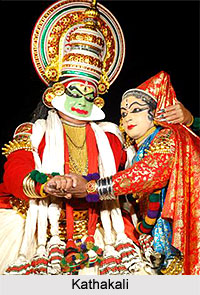 Influence of Kathakali on Yakshagana has been immense. The prose plays of Kannada theatre makes all the difference between Yakshagana and its counter-part in Kerala- the Kathakali. A comparison between the two will reveal the close relation between them and hint at their possible common origin. Kathaka-Kala, Kathaka Keli is the extant Kathakali which portrays a theme through the medium of dance (Nritya), music (Gana) and gesture (Mudra), without employing prose, and the mainstay of Yakshagana is prose. But both Yakshagana and Kathakali draw their themes from epics like Ramayana and Mahabharata; both of them emphasise on rousing the sentiments of Raudra and Veera; their costumes, ornaments, musical instruments and even the make up and method of presentation are similar. Their settings with an occasional single back curtain, the Bhagavata and his accompaniments, the stage set in the middle of the surrounding audience and the oil-torch are close to each other; both are performed on significant occasions and festivals and both of them beat Chande, a high pitched percussion instrument to invite the neighbouring villagers to the performance.
Influence of Kathakali on Yakshagana has been immense. The prose plays of Kannada theatre makes all the difference between Yakshagana and its counter-part in Kerala- the Kathakali. A comparison between the two will reveal the close relation between them and hint at their possible common origin. Kathaka-Kala, Kathaka Keli is the extant Kathakali which portrays a theme through the medium of dance (Nritya), music (Gana) and gesture (Mudra), without employing prose, and the mainstay of Yakshagana is prose. But both Yakshagana and Kathakali draw their themes from epics like Ramayana and Mahabharata; both of them emphasise on rousing the sentiments of Raudra and Veera; their costumes, ornaments, musical instruments and even the make up and method of presentation are similar. Their settings with an occasional single back curtain, the Bhagavata and his accompaniments, the stage set in the middle of the surrounding audience and the oil-torch are close to each other; both are performed on significant occasions and festivals and both of them beat Chande, a high pitched percussion instrument to invite the neighbouring villagers to the performance.
Kathakali conveys in gesture every conceivable earthly and unearthly thought including even parts of speech, and therefore, it is said that Kathakali covers more ground than Yakshagana which is less symbolic and more rigid in its import. The art of gesture is a specialised science with Kathakali, its dance is more vigorous with varying rhythms, its make-up is more imposing though it is said to be less indigenous. All these are differences only in degree rather than in kind. Methods of make-up and costumes in the Yakshagana of Tenku Tittu (of the Southern coast) are very close to the methods employed in Kathakali and seem almost its replica. This close similarity even in the details of Yakshagana and Kathakali indicates the possibility of there being two branches of the same basic art.
Kathakali`s emphasis on dance and music suggests also that its original pattern might have been the purer and earlier form of Yakshagana before the latter accepted the spoken word as its main medium of expression. Kathakali is given quite a recent origin. The origin of Kathakali, historically, is associated with Malabar and more particularly with Travancore which remains to this day the repository of the art. The Raja of Kottarkara (1575-1650) is credited to be the first composer and originator of Kathakali in its present form. It is said that the present form of Kathakali was originated in the early 17th century by Kottarkara Tanpuran who composed Ramanattam in rivalry with Mahadevan Zamorin of Calicut, the celebrated author of Krishnanattam ; a composition on the lines of Geeta Govinda of Jayadeva. Both the compositions are in eight cantos and deal with the heroes of the epics, but the fundamental difference is in the language. While Krishnanattam was in Sanskrit language, the language used by Gods, Ramanattam was composed in Malayalam language. Thus the present form of Kathakali was evidently based on an old form, an already existing mode of the folk performance, older than even Krishnanattam with a loose framework and possibly dealing with indigenous themes. It was full of costumes, dance and gesture but certainly was not refined. A refinement was brought into this ancient and crude theatrical mode by the munificent royal patronage extended by Kings and Princes like Kottayathu Tanpuran, Kartika Tirunal and Uthram Tirunal who were themselves great composers of Kathakali. But the unrefined mode of Kathakali of antiquity was perhaps very near the Yekkalagana which was possibly full of music and dance, some shades of which could evidently be seen in the Bhootasthana, Naganritya and Vaidyara Kunita of today. It is of significance that it is only the present form of Kathakali that had its origin in the royal Courts of Travancore. Its ancient form may have had something intimate to do with Karnataka, the home of Yakshagana.



















